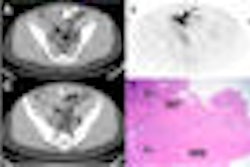Scientists from the Kimmel Cancer Center at Thomas Jefferson University in Philadelphia have discovered a possible way for malignant breast tumors to be identified without a biopsy, according to a study scheduled for publication in the January issue of the Journal of Nuclear Medicine.
Mathew Thakur, Ph.D., professor of radiology at Jefferson Medical College of Thomas Jefferson University and director of radiopharmaceutical research and nuclear medicine research, and colleagues studied an agent called 64Cu-TP3805, which is used to evaluate tumors via PET imaging. 64Cu-TP3805 detects breast cancer by finding a biomarker called VPAC1, which is overexpressed as a tumor develops.
The researchers compared images using that agent with images using F-18 FDG in MMTV-Neu transgenic mice that develop breast tumors spontaneously, like humans. The mice first received a PET scan using F-18 FDG, followed by a CT scan and then another PET scan using 64Cu-TP3805.
Ten tumors were detected in the mice. Four tumors were detected using both F-18 FDG and 64Cu-TP3805, and four additional tumors were found with 64Cu-TP3805 only.
All eight of these tumors overexpressed the VPAC1 oncogene on tumor cells and were malignant by histology. The remaining two tumors were benign and were detected only with F-18 FDG. They did not express the VPAC1 oncogene and, thus, were not detected by 64Cu-TP3805.
Related Reading
MRI, mammo help early breast cancer detection, December 9, 2009
Go directly to biopsy for palpable breast lesions? Not necessarily, December 7, 2009
Controversy can't alter facts: Screening mammography has proven benefits, December 2, 2009
MRI volume navigation adds accuracy to second-look breast ultrasound, November 11, 2009
BRCA1 carriers benefit from combo of FFDM and breast MRI, November 10, 2009
Copyright © 2009 AuntMinnie.com



















